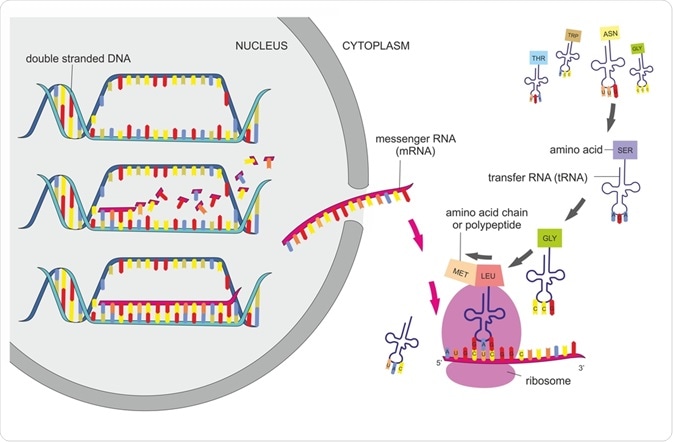Protein synthesis is a vital process that takes place within cells and is an essential mechanism for determining cell structure and function. The processes consist of two steps, transcription and translation.

Protein Synthesis. Image Credit: Soleil Nordic/Shutterstock.com
The first step involves synthesizing messenger RNA (mRNA), which then leaves the nucleus and travels into the cytoplasm where it attaches to a ribosome. At this point, the second step of translation begins where the genetic code of the mRNA molecule is read and used to create a specific protein molecule. Below, we discuss these two steps in detail.
For a more in depth guide to protein synthesis, click here!
What is Step 1 of Protein Synthesis?
The first stage of transcription involves the transfer of genetic information from DNA into mRNA. The purpose of this stage is to take the information stored in the DNA strand and copy it so that it can be used to create a particular protein molecule. During the phase of transcription, a strand of mRNA is synthesized to complement a specific segment of DNA. This happens in three steps.
First is the step of initiation, which represents the beginning of the transcription process. Here, the enzyme RNA polymerase locates and binds to an area of the gene known are the ‘promoter’. Once the binding has occurred, this signals the DNA strands to begin unwinding, allowing the enzyme RNA polymerase to read the bases of one of its strands. Once complete, the enzyme RNA polymerase can then synthesize a strand of mRNA composed of the same sequence bases.
Next, the step of elongation begins, where nucleotides are added to the strand of mRNA. Finally, once this step is complete, the final step of termination is initiated. Termination is the end of transcription, where the synthesis of the mRNA strand is completed and detaches itself from the DNA.
In humans and other eukaryotes, the newly created strand of mRNA must be processed before it can continue to the second step of protein synthesis, translation. Before processing, the new mRNA is known as pre-mRNA and before leaving the nucleus as mature mRNA must go through a final stage of processing. Often, this involves steps of splicing, editing, and polyadenylation. During these steps, the pre-mRNA molecule is modified, allowing one single gene to be used to create multiple proteins. Below we look at these steps in further detail.
Splicing relies on ribonucleoproteins found in the nucleus and involves the removal of regions go the genetic code, known as introns, from the pre-mRNA. This leaves the pre-mRNA with only protein-coding regions, known as exons.
The second step of processing is the editing phase. This is where changes are made to some of the pre-mRNA’s nucleotides. This editing allows for different versions of a single protein molecule to exist, such as the human protein APOB, which has two forms as a result of editing and works in the body to transport lipids in the blood.
The final step of processing is polyadenylation. This is where a tail of adenine bases is added to the strand of mRNA. The addition of this ‘tail’ signals the end of mRNA and also protects it from enzymes that may try to degrade it once it is exported from the nucleus.
What is the 2nd Step of Protein Synthesis?
Translation is the second step of protein synthesis. Once transcription and the following processing are complete, translation is initiated. This is where the newly created mRNA’s genetic code is read and used to produce protein molecules. Once mRNA leaves the nucleus it travels to a ribosome. Here, the ribosome reads the chain of codons in the strand of mRNA, and then tRNA transports the corresponding amino acids to the ribosome in the exact sequence.
Each molecule of tRNA has an anticodon to the specific amino acid it carries. Each anticodon has a complementary codon for the specific amino acid. This enables tRNA to transport the correct amino acids in the right order as coded on the strand of mRNA. Once the tRNA arrives at the mRNA with the correct amino acid it temporarily binds to it and gives up its amino acid which bonds to the previously added amino acid in the polypeptide chain. This chain continues to grow until a stop codon is presented.
From DNA to protein - 3D
Summary of the Steps of Protein Synthesis
Protein synthesis is an essential process that happens regularly within cells. The process is used to create new proteins that are used for various vital functions in the body. The process involves two stages of transcription and translation, with the need for processing in-between the two stages.
First, transcription transfers the genetic information from DNA to mRNA via initiation, elongation, and termination. Following this, the newly created strand of mRNA leaves the nucleus and attaches to a ribosome within the cytoplasm. This is where translation initiates. During this stage the genetic data is read, causing tRNA to transport the correct sequence of amino acids to the ribosome, creating a polypeptide chain. Finally, the polypeptide chain may go through the final processing to produce the finished protein molecule.
Sources:
- Dobson, C., 2003. Protein folding and misfolding. Nature, 426(6968), pp.884-890. https://www.nature.com/articles/nature02261
- Rötig, A., 2011. Human diseases with impaired mitochondrial protein synthesis. Biochimica et Biophysica Acta (BBA) - Bioenergetics, 1807(9), pp.1198-1205. https://www.sciencedirect.com/science/article/pii/S0005272811001526
- Vanzi, F., 2003. Protein synthesis by single ribosomes. RNA, 9(10), pp.1174-1179. https://www.ncbi.nlm.nih.gov/pmc/articles/PMC1370481/
Further Reading